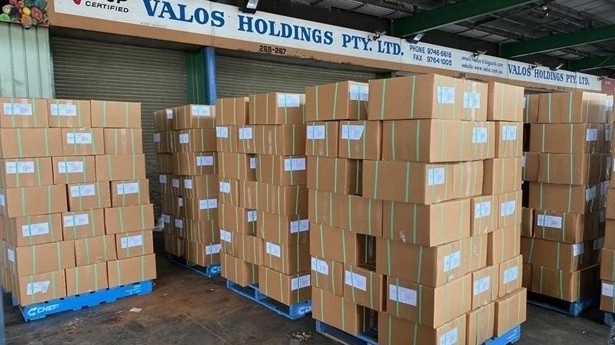Export growth not matching the potential
Vietnam has completed customs clearance procedures for seven tonnes of frozen durian into the New South Wales state of Australia, beginning the fruit’s journey to conquer consumers in one of the most fastidious markets in the world. This batch of durian was imported by the ASEAN Company, headquartered in New South Wales.
Nguyen Phu Hoa, Head of the Vietnam Trade Office in Australia, said that although Australia has not yet granted permission for the import of fresh durian, frozen durian has become a popular product in the country. In order to promote and boost the consumption of a typical Vietnamese product such as this, the Vietnam Trade Office in Australia has coordinated with the ASEAN Company to hold Vietnamese Durian Week, gathering many Asian people from July 20-31.
To further enhance the opportunity for the Vietnamese durian to penetrate the Australian market, the Vietnam Trade Office has promoted the organisation of Vietnamese Durian Week with an attractive programme, during which customers buying durian will have the chance to win luxury Vietnamese agricultural products. The promotion campaign aims to introduce a variety of Vietnam’s high-quality agricultural products to the Australian market, thus opening up market opportunities for the country’s products across different strengths. Following Durian Week, the Vietnam Trade Office will continue to work with several import agencies in Perth City ,Western Australia state, to launch a promotional programme for several batches of Vietnamese durian branded AAA, which ire expected to arrive in the state early next month.
The event is one of the trade promotional programmes aiming to bring Vietnamese products into Australia, one of the greatest potential markets under the CPTPP. More than a year since its coming into effect, the CPTPP created about encouraging initial results and has contributed to increasing the country’s export turnover.
According to the Ministry of Industry and Trade (MoIT), exports to CPTPP member countries witnessed positive growth in the first half of 2020, such as exports to Australia having increased by 2.3%, to Chile by 1.6% and to Mexico by 1.6%. Although the growth rate was not too high, this result is considered to be a cause for optimism in the context of the Covid-19 pandemic affecting the export turnover of goods.
Director of the MoIT's Multilateral Trade Policy Department Ngo Chung Khanh affirmed that the positive result of foreign trade activities with CPTPP member countries was the impact of overall reform. The CPTPP contains many contents related to reform requirements.
In 2019, Vietnam’s export turnover to CPTPP member markets recorded good growth, especially exports to the Canadian and Mexican markets, who do not have free trade agreements with Vietnam, increasing sharply by 26%-29%. In previous years, Vietnam’s trade deficit with the soon to be CPTPP bloc was US$0.9 billion per year; however, in the first year of the CPTPP agreement taking effect, the country reported a trade surplus of US$1.6 billion to the bloc. The trade surplus result continued to be maintained in the first half of this year with exports to many markets such as Canada, Mexico and Peru.
Promoting market opportunities
There are still vast opportunities for increasing market share in the CPTPP, but in fact Vietnam has not yet taken full advantage of these. Ngo Chung Khanh cited that only 43/63 provinces and cities have established trade relations with CPTPP member countries. Especially, less than 10 localities have had trade relations with the Mexican and Canadian markets which have only recently signed free trade agreements with Vietnam.
State management agencies have proactively pursued the agreement’s benefits in recent times. Accordingly, 577 seminars and conferences on the CPTPP were held nationwide in 2019. That was a huge number; however, the number of enterprises exporting to Mexico and Canada is still modest.
“The CPTPP is the most complicated agreement that we have ever negotiated. Even several articles in the CPTPP are more complex than the Vietnam – EU Free Trade Agreement (EVFTA). Therefore, it will be a pity if the enterprises do not take full advantage of it”, said Khanh.
Le Tien Truong, General Director of the Vietnam National Textile and Garment Group (Vinatex), said that the yarn-forward rule of origin in the CPTPP has become the biggest challenge making the textile and garment sector not take full advantage of the agreement. So far, Vietnamese enterprises still import over 50% of raw materials. Meanwhile, the plans for the development of the sector and raw material area have been left open.
Accordingly, textile and garment enterprises need the support of the Government in raising the localisation rate of raw materials, especially stage of dyeing and weaving that is facing numerous difficulties as many localities have rejected dyeing projects due to concerns about environmental pollution.
Chairman of the Vietnam Chamber of Commerce and Industry (VCCI), Vu Tien Loc, noted that in addition to the communications of FTAs among enterprises, the Government should reform institutions and quickly legislate commitments to create favourable conditions for enterprises. The VCCI official also suggested that businesses should improve their governance, diversify markets and build risk prevention systems.
In fact, the opportunity to increase exports to CPTPP member countries is huge after Japan officially opened the door for Vietnamese lychees this year. In addition, the People’s Committee of Mai Son district (in Son La province) on June 22 coordinated with the provincial trade promotion centre to hold a ceremony to export 30 first tonnes of mango in the year to the US, Canada and Australia. Australian consumers have been familiar with Vietnamese mangoes in recent years; however, this is the first Vietnamese mangoe shipment exported to Canada which is considered a potentially major market of Vietnam in CPTPP bloc. Vietnam’s durians have also begun to conquer the Australian market. The above opportunities are expected to contribute to increasing the country’s export turnover to CPTPP member countries in the near future.
















